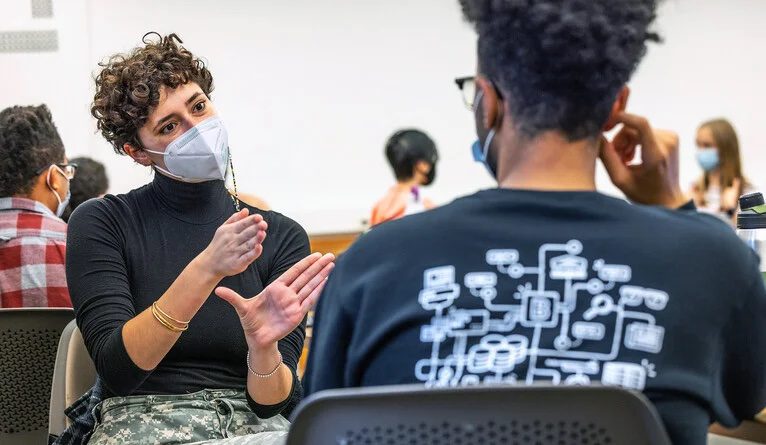American Sign Language now Yale’s third most popular language
Since it was first offered in spring 2018, American Sign Language at Yale has grown to be the third largest language option, with over 200 students enrolled in ASL classes this semester.

Yale News
In the spring of 2018, when American Sign Language was first offered at Yale, 20 students registered for the course. This fall, there are 257 students registered.
American Sign Language, or ASL, is now the third most popular language course offered at Yale.
“ASL is a beautiful and expressive language that captures the attention and interest of many individuals,” Zen Mompremier, an ASL lector wrote to the News. “Additionally, learning ASL can provide students with valuable communication skills that can be applied in various professional fields.”
ASL ranks third in popularity among all level one to level four classes and the level five classes not solely focused on language content. Fifteen different ASL sections are offered this semester: nine in level one and six in level three. Next semester, the course will offer 10 sections in level two, two in level four and an additional, topic-based level five course called “Critical Issues Facing Deaf People in Society.”
The course’s growth falls in line with national trends reflecting a growing popularity in studying ASL. The Modern Language Association’s 2020 report on language study indicates that ASL has the third highest enrollment of any non-English language throughout colleges and universities in the U.S. Moreover, it is the only language in the top 10 that saw increased enrollment from 2016 to 2020, with 2020’s 68,590 enrollees representing a 4.6 percent increase.
“I’m thrilled that the program has seen such growth in recent years,” Faculty of Arts and Sciences Dean Tamar Gendler ’87 wrote, citing Yale’s emphasis on the liberal arts as a factor for growth. “Students of the liberal arts learn to think, reason, and communicate across disciplines, and the curiosity about language, communication, and community that thrives in this environment may draw students to study ASL.”
Raffaella Zanuttini, the chair of the linguistics department, which oversees the ASL program, said there are “a number of factors at play” in relation to the course’s growth.
Some students have friends or relatives who are deaf or hard of hearing. Others, she added, “see it as an opportunity to contribute to building a more inclusive society” or enjoy a language where gestures are used rather than sounds.
Many students, according to Zanuttini, decided to pursue learning ASL as a part of their career goals — in health care, teaching, policy-making, or even sound engineering — and a desire to make these areas more accessible.
“I was interested in it because I had seen an ASL interpreter in theater,” Margarita Blackwood ’27 said. “I am very interested in sound engineering on stage because it is really important that everyone can understand what is happening.”
Blackwood also told the News that many of her peers are taking ASL because they are interested in pursuing careers in medicine and want to know ASL to help treat patients.
A typical ASL class at Yale aims to “ensure comprehensive learning,” Mompremier explained. Lectors use teaching methods ranging from PowerPoint presentations and video resources to service projects that connect Yalies with the deaf community. The department also hosts weekly lunchtime signing tables where students can practice their skills.
According to ASL Program Coordinator Julia Silvestri, the Linguistics Department has responded to students’ rising interest by increasing the number of instructors and sections offered of level one and level three ASL. From 2017 to 2020 there were only two sections available for all levels. In 2023, this number increased to nine. The department has also added at least one lecturer each year since 2021. There are five ASL lecturers teaching this fall.
Yale’s peer schools have recently seen an expansion in ASL classes offered.
Harvard University’s Department of Linguistics used to offer beginning ASL courses for credit until 1994. However, they were discontinued until 2016 when Harvard’s Department of Linguistics began offering ASL courses for credit again. At Harvard, there are more students who have an interest in taking ASL than can be accommodated with the current class capacity. Princeton also offers ASL for credit, which began in 2018 and has since expanded its offering of 100-level ASL courses.
The first permanent school for the deaf was opened in Hartford, Connecticut in 1817.







